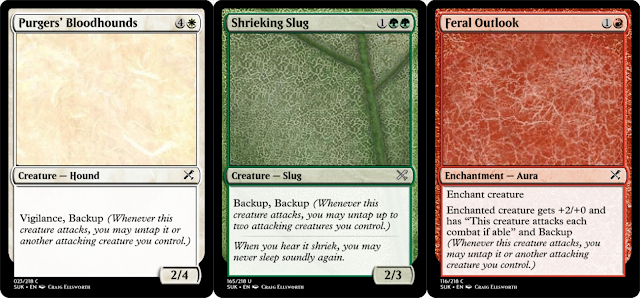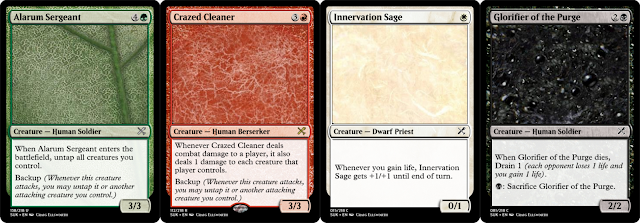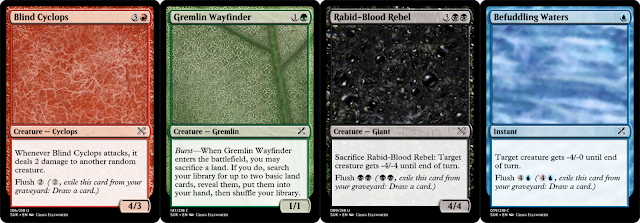My next Magic set I began running with
shortly after finishing Ruin of Seffala—that is, shortly after
finishing the last card over a year ago.
Ruin of Seffala was meant to be a
serious set that I thought I could be proud of. I would say the
mishmash of tribal themes was a bit disjointed, and the mechanics
were nonbos, such as the original idea of Toughlink (when the
creature dies, you gain life equal to its toughness) being completely
negated by Wither (as a creature that dies from -1/-1 counters has a
Toughness of zero when it dies).
So, having learned that I was bad at
"serious" sets, I thought I'd take a break and make
something funny.
Since every videogame has a requisite
sewer level, I decided to make a sewer-themed Magic set. After
hemming and hawing over made up plane (or perhaps city) names, I have
settled on Sewers Under Kasprah, or SUK.
Being a sewer theme, I wanted to come
up with mechanics that were hilariously named, even if they were
seriously designed. I kind of went for a top-down design, coming up
with possible mechanic names first that would match a sewer (or
rather plumbing) theme, and then tried to come up with mechanics that
sounded like they fit the name.
So I'll start by showing off the five
major new mechanics I designed. Each mechanic can be found in three
colors, but I follow neither wedges nor shards; however, it does all
balance out so each color gets exactly three new mechanics. I worked
hard to theme them nice!
Naya, the aggro colors, get BACKUP.
 |
| Click to embiggen. Lots of cards this post! |
Backup is fairly
simple: it's kind of a triggered, moveable Vigilance. Whenever a
creature with Backup attacks, you can untap it or any other attacking
creature you like. Since the ability goes on the stack (unlike
Vigilance), there is an opportunity to react to the trigger.
Since I have my
own pseudo-Vigilance, I tried to not use too much real Vigilance.
There are a few cases so far, but these are more used like bonuses,
such as with Purgers' Bloodhounds here, so that you don't have to
'spend' your Backup trigger on the creature you're attacking with
itself. Instances of Backup stack, as you can see with Shrieking
Slug, which by itself has two instances of Backup.
Abzan, the colors
of life and death, get DRAIN.
Drain is a
well-known mechanic that only has this as an unofficial name, so I
codified it here. Drain is another simple keyword that can be
activated or triggered. When an instance of Drain X occurs, each
opponent loses X life and you gain X life. We've seen this ability a
million times in Black, and I decided the other colors of lifegain
could use them as well. Here are a bunch of options, where you can
have it tacked on to an Instant or Sorcery, as an activated ability,
or as a triggered ability.
Temur, my favorite
colors, get BURST, my favorite mechanic (which will likely
always be the case).
Burst is more of a
reminder word for an ETB effect. Burst always begin with "When
this permanent enters the battlefield, you may sacrifice a land. If
you do...", and then you get some bonus. I figured Temur would
be great for this mechanic: Green is the color of putting extra lands
into play; red is the color of short-term gain and high-risk,
high-reward; and blue is the color of card draw, so you're likely to
hit your land drops. Each instance of Burst always gives a fun
different bonus, and depending on your strategy, you may not want to
load up on them, or you may decide not to activate the bonus, since
it is not mandatory.
Esper, the control colors, get PLUNGE.
Plunge is a
keyword ability that kind of mixes and matches what blue and black do
best, while inverting the fairness inherent to white. Plunge has you
exiling the top card of your opponent's library (a slow mill plan if
you wish), and you get to Scry X, where X is the converted mana cost
of the exiled card. If you exile a land, bummer, and if you exile
your opponent's eight-mana bomb, you get to really stack your deck.
Grixis, the colors
of card advantage, get FLUSH.
Grixis has a very
simple mechanic, that mixes the card advantage of red and blue with
the graveyard shenanigans of black. You simply pay the Flush cost,
exile the flushed card out of your graveyard, and you get to draw a
card. The Flush cost usually scales, so the greater the CMC of the
card, the smaller the Flush cost. Quite frankly, with its simplicity, I'm surprised there is not another mechanic already just like it (at least not that I could find).
With all of these
three-color mechanics designed, I set to work making four-color
clans. These are rarely 'tribes' because it's not so much a creature
or class tribal set, but just in terms of story, there are five
four-color factions.
Above the sewers,
in Kasprah, there are gangs duking it out in a post-apocalyptic
Seffala-meets-Kaladesh hellscape.
Below the sewers,
we have the Survivors. Survivors are primarily intelligent creatures
that have gone down into the sewers to escape the war-torn city above
and try to live on slime. Survivors are most Homunculi, Mutants, and
Orggs. These Survivors are mostly strangely-bred creatures that were
raised to do the bidding of one faction or another above, but got
away. Survivors make up the 'Artifice' slice of the color pie,
meaning White, Blue, Black, and Red. They utilize the new mechanics
of Plunge and Flush.
Heading down into
the sewers to clean them out are the Purgers, mostly Humans and
Dwarfs that form what might be thought of as the police state or
armed forces of Kasprah. Their task is to clean out the nuisances of
all living creatures in the sewers. I like to picture them as having
flamethrowers. They take up the Aggressive colors of White, Black,
Red, and Green, and use Backup and Drain as their mechanics.
The Scavengers are
primarily Horrors that live in the sewers, feasting both on the flesh
and the psyche of all the enter. Scavengers can be all manner of
creatures that would naturally swim in the muck, including Merfolk,
Cephalids, Fungi, Homarids, Leeches, Moles, Naga, Ooze, and Rats.
Since they feast so well and live like kings in their watery domain,
they take up the Growth portion of the color pie: White, Blue, Black,
and Green. Their mechanics are Drain and Plunge.
The Beasts (the
generic term here, not the creature type) make up the
less-than-intelligent creatures that live in the sewers. More beef
than brains, these creatures are big boys that chomp their prey to
pieces. They can be Crocodiles, Basilisks, Jellyfish, Crabs, Fish,
Krakens, Octopi, Frogs, Lizards, Slugs, Snakes, and Squids. I love
variety in my beasties. They make up the Altruism slice of the pie
(for lack of a better word, since they're generally too dumb for
morals), with White, Blue, Red, and Green. Their mechanics are Backup
and Burst.
Lastly, we have
the Rebels. Above all, these are the guys the Purgers are really
going after. The Rebels are the gangs that are going to war above,
and use the sewers as ways to get around the city undetected. They've
got the waterways mapped out, and even know how to lay traps for
their foes. Rebels are mostly monstrous humanoid types, like Giants,
Ogres, Orcs, Cyclopi, Minotaurs, and Gremlins. In their quest for
destruction and anarchy, they make up the Chaos slice of the pie:
Blue, Black, Red and Green. Rebels get the mechanics of Flush and Burst.
Perhaps for story purposes I'll add watermarks to each clan, if I can either find or create good-looking watermarks.
After coming up
with all of these mechanics, themes, stories, factions, etc., I blew
through a slew of interesting ideas for commons and uncommons, and a
few rare and mythics, but I started to slow down and get stuck. Then,
out of boredom, I kind of created two-color subthemes for variety, so
that there was more focus and differentiation between two colors that
might belong in the same wedge or shard. And this is where I'm at:
I'm currently experimenting with putting small spins on the
overarching themes, like having Blue/Black have a greater emphasis on
Mill, and Red/White have a lot of equipment. With Seffala, I stopped
myself from making extra cards as soon as I hit the limit, but now
I'm experimenting, and I hope to generate far more cards than
necessary, and start to cut them back when I have too many (perhaps
save some ideas for a sequel). All of the sample cards above have the
possibility of being cut or reworked.
But, so far, I am
much happier with this effort than my first; though it started off
with silly plumbing-themed mechanics, it quickly grew into a serious
set with interesting characters. Now I just hope it plays better...









